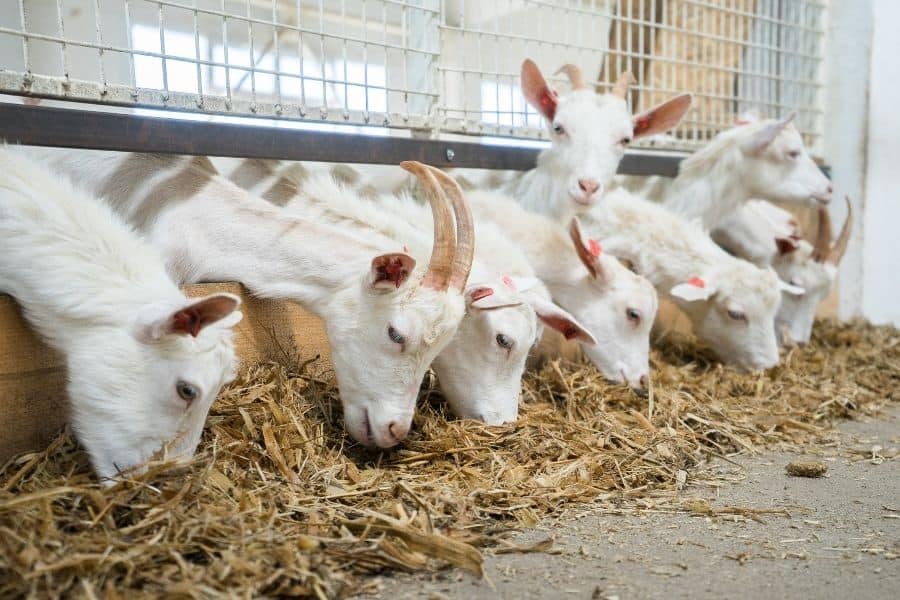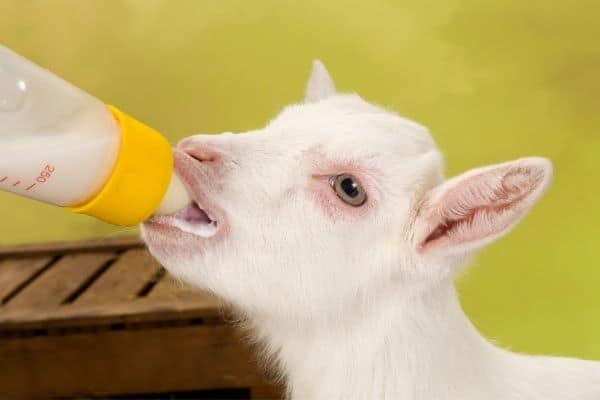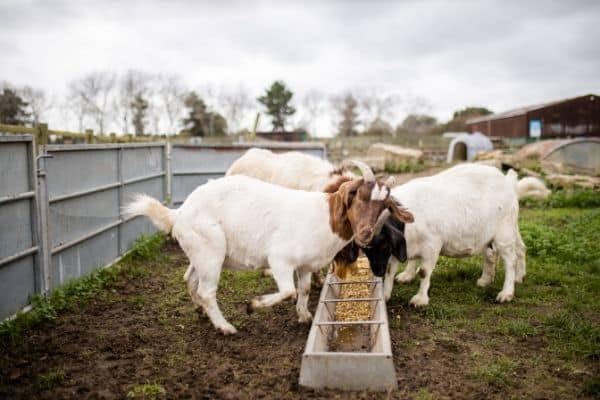To retrieve the best quality milk from a dairy goat, it is important to feed them properly. This involves giving goats food that is high in quality and the right amount in quantity.
The amount that dairy goats consume depends on their age, with kids having a very different feeding schedule than the milking herd. Other factors, such as weight and lactation, also influence the amount that dairy goats eat. In general, dairy goats should eat around 5 percent of their body weight daily.
Understanding the different stages of life for dairy goats is important when it comes to feeding them.
What to Feed Dairy Goats?

Dairy goats are goat breeds that are used for milk production. Common dairy goat breeds are Alpine, La Mancha, and Nubian goats. The feeding process for a dairy goat varies based on age.
To encourage quality milk production, diets must be high in energy and protein while easy to digest. Some of the minerals that should be included in the food are calcium, phosphorous, and sodium.
Foods that are packed with these ingredients include hay and grains. Most goats are fed roughages, which are dietary fibers. Ideally, a dairy goat should have access to a pasture filled with herbs, weeds, and grass. Several plants offer an assortment of minerals that can benefit the goat’s health. These include:
In addition to food, water is essential to the milk production process. Goats need to drink a high quantity of water every day.
Feeding Goat "Kids"
Dairy goats that are less than a year in age are called “kids.” The process of feeding a kid precisely depends on her stage of life.
Feeding Soon After Birth
Feeding kids properly at birth is essential because it can protect them from infectious pathogens. Here are the steps to feeding a newborn dairy goat:
Through this process, the doe receives necessary milk while staying protected from any pathogens that may reside on the doe’s skin. After this first feeding, kids can nurse directly from the mother. However, some people may prefer to continue feeding kids by hand; they store the milk in this case.
For the first three days of a kid’s life, they should be fed about ½ cup of milk 4-5 times a day.
If you choose to hand-feed the kids, make sure to wash utensils properly after each feeding. Milk should be warmed to 100 degrees Fahrenheit.
A Few Days Old
From four days to two weeks, kids should be fed between 8 to 12 ounces of milk 3-4 times a day.
At this age, kids can be fed milk replacer. This is a formula that serves as a substitute for the mother’s milk. It is also a more affordable alternative. Here are the qualities that make a good milk replacer:
Lamb and calf milk replacers are acceptable.
2 Weeks Old
Between the age of 2 weeks and 3 months, goat kids should be fed around 16 ounces of milk 2-3 times a day. At this age, solid foods such as hay and grain can be introduced. Their water intake should also be increased.

3-4 Months Old
The milk consumption at this point is similar to that of 2-week old kids. At 3 to 4 months, kids should consume 16 ounces of milk 2 times a day. Once kids start feeding on hay regularly and consume at least ¼ pound of hay, their milk intake can be reduced gradually.
6 Months+
After six months of age, kids can start eating a portion that would typically be fed to a milking herd or dairy goats that are old enough to be milked. This involves quality hay and about ½ pound of grain daily. If hay is not high quality, increase the grain intake to at least 1 pound.
Feeding Milking Herd
Most dairy goats can produce milk from about 18 months of age. Their food should consist of quality hay and legumes mixed with grain packed with protein, vitamins, and minerals.
The amount a milking dairy goat consumes is determined by a number of factors, including:
If the hay is high in quality, you can feed the goat less grain. Similarly, if you have a large amount of hay and legumes, you can lower the grain amount.
Goats that are skinny and produce high quantities of milk need to eat more than goats that produce low levels of milk or goats that are overweight.
In general, lactating goats should eat a pound of grain for every 3 pounds of milk they produce.
For goats that lactate late, they should eat a pound of grain for 5 pounds of milk. Dairy goats should be fed proper grain rations.

Grain Rations
In general, dairy goats can consume the same grains as dairy cows. There are several different grain options, each with its own pros. The table below illustrates these.
Grains | Advantages |
|---|---|
Rolled/cracked grain | Tastier than ground grain |
Molasses | Tasty (wet is preferable to dry) |
Citrus pulp | High level of fiber |
Other recommended grain rations include rolled oats and soybean oil meal. Commercial cow feeds are not advised because they may contain ingredients that do not favor a goat’s palate.
Grain rations should be combined with a vitamin premix. This premix should contain vitamin A, vitamin D, and vitamin E.
Feeding When Goat is not Lactating
When a doe is not lactating, her feeding schedule should be adjusted accordingly. Grain should be decreased to between ½ - 1 pound. However, the doe can consume as many plants in the pasture as she desires. Leaves and weeds are recommended because they can help repair any stomach issues.
6 Important Tips for Feeding Goats
If you want your goat to stay healthy and produce quality milk, then you need to feed her properly. Here are some feeding tips to maintain optimal health:
- 1Feed kids with the goal of growth in mind
- 2Feed adults with the goal of weight maintenance in mind
- 3Feed extra during gestation and lactation
- 4Balance grain with plants
- 5Ensure diet includes digestible fiber
- 6Maintain proper temperature
Temperature Consideration When Feeding Goats
Dairy goats cannot function well if they are not comfortable. Feeding a dairy goat properly is useless if the temperature is off. These animals prefer a temperature between 55 and 70 degrees Fahrenheit.
Temperatures lower than 55 degrees will typically not affect feed consumption, but an environment over 80 degrees may result in the dairy goat refusing to eat.
Check out this robotic goat feeder from Lely on a goat farm in holland
Monitor Your Goat Diet
In addition to these steps, you should feed dairy goats the recommended amount for their age group. However, keep in mind that not all dairy goats are equal, and proper adjustments need to be made according to weight and lactation.
Remember that goats, like people, have appetites. One goat may consume more than another goat of the same age and weight. If the goat becomes overweight, adjust her diet accordingly.
Conclusion
Ultimately, there is no straight answer when it comes to how much you should feed your goat. The goal of feeding should be the same in every case: maintaining the goat’s health while receiving milk. To achieve this goal, take proper care by adjusting the goat’s feeding schedule as she grows and catering to her individual needs.
